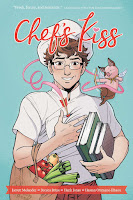One of my favorite bookish surprises is to find out that whatever I’m reading has recipes included in it. Not a cookbook, mind (though those are great too!), but a novel or a graphic novel with recipes after each chapter or at the end of the story. Going into it, I didn’t know that graphic novel Chef’s Kiss by Jarrett Melendez, Danica Brine, Hank Jones, and Hassan Otsmane-Elhaou would be one of these books. What I did know? Cooking plot, romance, gay protagonist, and I saw the cute, piggy cupid on the front cover – and that was more than enough to sell me on this title. I’m so glad it did! And I’ll be checking out the recipes too.
Watch things start to really heat up in the kitchen in this sweet, queer, new adult graphic novel!
Now that college is over, English graduate Ben Cook is on the job hunt looking for something…anything…related to his passion for reading and writing. But interview after interview, hiring committee after hiring committee, Ben soon learns getting the dream job won’t be as easy as he thought. Proofreading? Journalism? Copywriting? Not enough experience. It turns out he doesn’t even have enough experience to be a garbage collector! But when Ben stumbles upon a “Now Hiring—No Experience Necessary” sign outside a restaurant, he jumps at the chance to land his first job. Plus, he can keep looking for a writing job in the meantime. He’s actually not so bad in the kitchen, but he will have to pass a series of cooking tests to prove he’s got the culinary skills to stay on full-time. But it’s only temporary…right?
When Ben begins developing a crush on Liam, one of the other super dreamy chefs at the restaurant, and when he starts ditching his old college friends and his old writing job plans, his career path starts to become much less clear.
Ben and his friends have just finished up college, and they are living together while figuring out what happens next: more schooling, job hunting, first job woes, etc. Ben, an English major, is not having any luck applying to jobs that might use his degree – and he’s feeling a little desperate one day when he sees a “Help Wanted” sign at a restaurant. Then it turns out that staff member Liam is hot, Ben gets to use his cooking skills, and (most) of the staff is nice… could this be the thing he’s meant to do? A gourmet food-loving pig will decide his fate, and Ben will have to wrestle with disappointed parents, friend conflict… and maybe dating too, if he’s lucky.
One of the lovely bits of Chef’s Kiss is that the side characters, Ben’s
friends and coworkers, all have real moments in the story, from nonsensically
talking about a bong decorated like Vlad the Impaler amid a friend negotiation,
to a quick moment of asking someone to celebrate you transforming from surprise,
to misunderstanding, to hurt when folks aren’t on the same page. I appreciated the
healthy resolution of those moments. It may not have resulted in the most
drama-filled plot, but it is excellent modeling for readers, and that’s okay to
have sometimes! I also appreciated the conversation throughout the book about “what’s
next” after college, and the affirmation that it’s okay not to know. So
not only was this a cute and satisfying book, I felt that it was rewarding,
too. I’m looking forward to putting it in my classroom library.
As with any graphic novel, the art plays a huge role. Danica Brine’s line art and Hank Jones’ color feel like a cross between manga and traditional superhero comics styling, and it is of course beautiful! The focus on each page is definitely on the clean lines and dialogue. I think this is the most text-heavy graphic novel I’ve read in a while. As a result, I got a sense of each character’s voice, which was a good thing. I also loved the art in the back matter, including the illustrated recipes (of course!) for Mushroom Ricotta Tart and Butternut Squash Soup.
The only thing I take issue with about this book is that the back cover (e.g. the publisher) calls it a romance. I think it is more of a coming-of-age story, with a little bit of incidental romance along the way. I say that because it doesn’t feel as though the romance is the POINT of the book – instead, the point is settling into adulthood, figuring out what you want to do, doing your best, and showing up for the people around you. Also, the romantic bits are quite innocent, so it definitely feels sweet in a YA kind of way. And none of this is a real criticism! I think the story and art are lovely and they don’t need a heavier romantic element. I just tried to think of a quibble and found one, don’t mind me, lol.
In all, Chef’s Kiss is an adorable, light read with: a satisfying conclusion, notes on healthy friend and family relationships, a hilarious pig character (and I do mean character), recipes at the end (!), and a sprinkling of romance.
Recommended for: fans of Bloom, Our Dining Table, Check, Please!, and other food-themed graphic novels and manga, and those looking for sweet LGBTQ+ reads with a similar wholesome- and friendly-feel to Alice Oseman’s Heartstopper.
This review is part of Weekend Cooking, hosted by Marg of The Intrepid Reader. Click to learn more about Weekend Cooking.

















